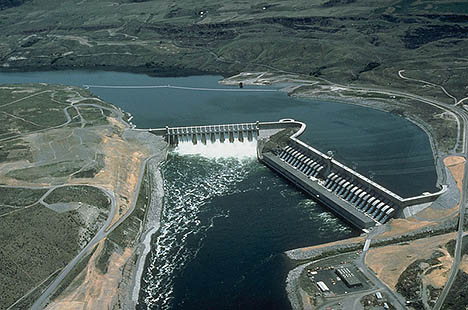 Compared to other renewable energy technologies, the sheer multiplicity of wave, tidal and hydrokinetic power devices indicates that the potential for generating power from the world’s oceans and rivers is considerable. There are more than 100 different marine and hydrokinetic devices currently being developed, tested and deployed by various companies, according to a recent Pike Research report, and the Ocean Renewable Energy Coalition estimates that as much as 10 percent of U.S. power needs could be met from these unconventional hydropower resources.
Compared to other renewable energy technologies, the sheer multiplicity of wave, tidal and hydrokinetic power devices indicates that the potential for generating power from the world’s oceans and rivers is considerable. There are more than 100 different marine and hydrokinetic devices currently being developed, tested and deployed by various companies, according to a recent Pike Research report, and the Ocean Renewable Energy Coalition estimates that as much as 10 percent of U.S. power needs could be met from these unconventional hydropower resources.
Point Absorbers
Several kinds of devices can generate electricity from wave energy and in most cases, undersea power cables carry the energy to shore. A point absorber is a floating device with parts that move relative to each other in response to wave motion and can use hydraulic, pneumatic or direct-drive systems. A direct-drive permanent-magnet generator device built by Columbia Power Technologies (CPT), located in Virginia, is an example. Built of fiber-reinforced plastic that doesn’t corrode in harsh sea conditions, CPT’s prototype SeaRay is designed to work with the least number of moving parts, thereby increasing efficiency and reducing the chance of parts that can break, according to CEO Reenst Lesemann.
“In its simplest form, there are two wings, forward and aft, and a cell in between. Each wing is directly connected to a generator. Each wing and cell move independently of each other,” describes Lesemann. “We are trying to exaggerate the motion of the device.” The SeaRay’s average output is hundreds of kilowatts (KW), and the peak output is a megawatt (MW). One of its advantages, Lesemann said, is that the parts are modular: “If a piece goes bad, it doesn’t have to bring the whole device down.” The company’s next step is to build a utility-scale model of the SeaRay that is seven times larger, called the Manta.
 Ocean Power Technologies’ (OPT) PowerBuoys are another example of point absorbers. The PB150 generates 150 KW by bobbing up and down with the motion of the waves. The mechanical motion is converted via a power take-off that drives a generator inside the buoy. Built of steel, the buoys’ sizes range from the PB150 up to the PB500 (maximum capacity of 500 KW). Currently, OPT, which is based in Pennington, NJ, is in the final planning phases of a 1.5-MW wave power park 2.5 miles off the coast of Reedsport, OR. It will be the first commercial project off the west coast of the United States, and will feature ten PB150 buoys, an undersea substation, and a submarine cable. The company expects deployment of the buoys to begin in mid-2012.
Ocean Power Technologies’ (OPT) PowerBuoys are another example of point absorbers. The PB150 generates 150 KW by bobbing up and down with the motion of the waves. The mechanical motion is converted via a power take-off that drives a generator inside the buoy. Built of steel, the buoys’ sizes range from the PB150 up to the PB500 (maximum capacity of 500 KW). Currently, OPT, which is based in Pennington, NJ, is in the final planning phases of a 1.5-MW wave power park 2.5 miles off the coast of Reedsport, OR. It will be the first commercial project off the west coast of the United States, and will feature ten PB150 buoys, an undersea substation, and a submarine cable. The company expects deployment of the buoys to begin in mid-2012.
Sea Snake
Another type of wave power device — an attenuator — floats on top of the water and in parallel to the direction of the waves. Several segments are connected together like a long sea-snake. Pelamis Wavepower (named for the Pelamis platura, a sea snake), based in Edinburg, Scotland, has engineered a steel attenuator device built of five segments that flex in two directions. As the joints flex in response to waves, the motion is converted via hydraulic power take-off systems inside each joint. The device is rated at 750 kW with a target capacity factor of 25-40 percent.
In 2008, Pelamis built the world’s first wave farm off the northwest coast of Portugal and the company currently has 170-MW worth of projects underway in UK waters, including projects for utility customers E.ON and Scottish Power Renewables. The company doesn’t have any projects in the United States or Canada yet, but envisions that it will move into that market in the long term, especially given the “huge potential for generating electricity from the waves around North America,” Deborah Smith of Pelamis said.
Harnessing Tidal Currents
Instead of waves, tidal energy devices use the movement of tides to generate power. According to the Ocean Energy Council, the total world potential for ocean tidal power has been estimated at 64,000 MW-equivalent. Since water is more than 800 times as dense as air, tidal devices (which often look like wind turbines) can generate as much energy as wind turbines, but on a much smaller technological scale and at slower water current speeds.
Ocean Renewable Power Company (ORPC), based in Portland, ME, developed a turbine-generating unit (TGU)—a gearless device made of corrosion-resistant composite materials. The TGU can be configured modularly. For example, in small rivers, the RivGen system combines a TGU with a support frame that rests on the riverbed. In deep ocean waters, the OCGen system stacks several TGUs on top of one another in a bouyant array that takes full advantage of ocean currents. According to Chris Sauer, president and CEO, the company is planning a prototype model of the OCGen system this fall, and plans to build a 1-MW module off the coast of Florida in the Gulf Stream.
Right now, ORPC is launching the first grid-connected U.S. tidal energy system in Cobscook Bay, ME. “This is a huge step forward for the U.S. industry,” Sauer said. “We will be breaking water on our first device in March—a 180-kW, single device power system that we hope to have connected to the grid to Bangor Hydro’s system in June.” The company gradually will add more modules in Cobscook Bay, Kendall Head, and Western Passage, building up to a 29-device, 5-MW installation by the completion of phase 3.
Verdant Power, based in New York, NY, has developed a free-flow kinetic hydropower system with a rotor and three blades. The turbines rotate at about 35 RPM, generating motion that then drives a speed increaser, which in turn drives a grid-connected generator. Verdant’s device also features fully bidirectional operation on both ebb and flood tides.
Last January, the Federal Energy Regulatory Commission issued a pilot commercial license for Verdant’s Roosevelt Island Tidal Energy (RITE) Project in the East Channel of the East River in New York City, making it the first commercially-licensed tidal energy plant in the United States. The plant will have 30 turbines that have a generating capacity of up to 1 MW.
Verdant Power Canada also is seeking to tap into the estimated 15,000 MW of hydrokinetic capacity in Canada via its Cornwall Ontario River Energy (CORE) project. At completion, the project will convert the currents of the St. Lawrence River into energy. It’s estimated that as much as 15 MW of generating capacity will be able to be harnessed.
Tapping into Dams
Though it doesn’t use waves or tides as an energy source, HydroGreen of Westmont, IL has developed a hydrokinetic technology that piggy-backs on existing low-head hydropower sites. The technology, which the company calls a “plug and play” modular hydropower solution, is a run-of-river turbine with a capacity factor of 55-90 percent.
A 2009 Navigant Consulting report estimated there are 74,000 MW of this kind of hydrokinetic potential in the United States, mostly at non-powered dams. Combined with the waves and tides that surge over much of the earth’s surface, the non-conventional hydropower industry, with commercialization within arm’s reach, is poised to tap into a vast supply of renewable energy.
Source: renewableenergy.com





































